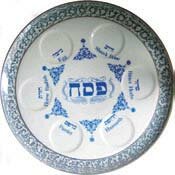| Understanding the basics for Pesach |

|

|
|
The holiday of Passover marks the anniversary of the birth of the Jewish nation. The story of the Jewish nation is one of individuals who became a family who became a people. The great individuals who laid the spiritual foundation of Jewish peoplehood were Abraham and Sarah, their son and daughter-in-law Isaac and Rebecca, and their son and daughters- in-law Jacob, Rachel, and Leah.
From Jacob, Rachel, and Leah came a family of 70 people who, due to a famine in Israel, were forced to migrate to Egypt. In Egypt this family grew and prospered to such an extent that they eventually came to be seen as a threat by their Egyptian hosts. Respect and admiration turned to contempt, and fi nally to an organised programme of enslavement and oppression. After 210 years, and a series of unheeded warnings by Moses to Pharaoh which resulted in the Ten Plagues, God liberated a nation which had grown from the original family of 70 people. Seven weeks later this newly conceived nation received the Torah at Mount Sinai. The Haggadah is the story of the birth of the Jews as a people. It deals primarily with the events in Egypt which led from slavery to liberation, though it also spans the entire period from Abraham to the giving of the Torah at Mount Sinai. One could say that the Haggadah is our national birth certificate as well as our Declaration of Independence. More than just a historical document, it also speaks of the ideals and values which constitute the essence of our national consciousness and identity. The word Haggadah means to tell, or to relate. The Haggadah is a vivid narrative which is set in the context of a parentchild dialogue. Passover, with the Haggadah as its focus, tells every Jew three things: who you are, where you came from, and what you stand for. This text and these questions are the basis for the Seder. Why is it Called a Seder? KADESH: To begin the Seder, we make Kiddush and sanctify the day. URCHATZ: Wash our hands without a blessing. KARPAS: We take a green vegetable and bless God for creating fruits from the ground. The reward is emancipation. YACHATZ: We break the middle matzah, and put it aside to serve later as the Afi komen. MAGGID: The Sages tell us that the unique ability given to humanity is the power of speech. Speech is the tool of building and construction. RACHTZAH: At the Seder we wash our hands as a preparatory step before the Matzah, in order to carefully consider what it is we are about to eat. MOTZI: We make the “hamotzi†blessing to thank God for “bringing forth bread from the ground.†MATZAH: We eat the unleavend bread. MARROR: At the Seder, we eat the bitter herbs — in combination with Matzah — to underscore that God is present not only during our periods of freedom (symbolized by theMatzah), but during our bitter periods of exile as well. He will never forsake us. KORECH: The Hillel Sandwich is “bricks-and-mortar:†broken Matzah held together by bitter herbs and charoset. SHULCHAN ORECH: When we think of attaining levels of holiness, it seems strange that one of the mitzvots of Seder night should be eating a festive meal. TZAFUN: The last thing we eat all night is the Afi koman. BARECH: “Grace After Meals†HALLEL: God delivers us from slavery unto freedom — and we are amazed at the beauty and swiftness of it all. NIRTZAH: We conclude our Seder with the prayer, “Next Year in Jerusalem.†Every synagogue in the world faces Jerusalem. It is the focus of our hopes and aspirations — not merely in a geographic sense, but in a conceptual sense as well. Article supplied by Aish.com (Issue April 2009)
|


















